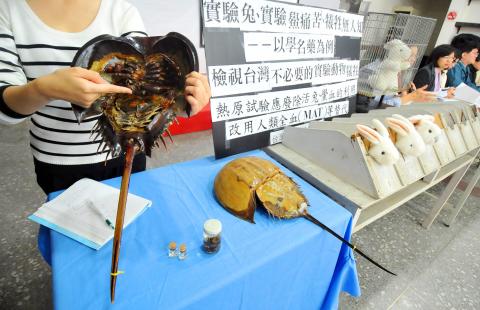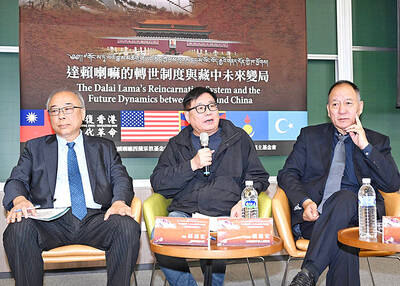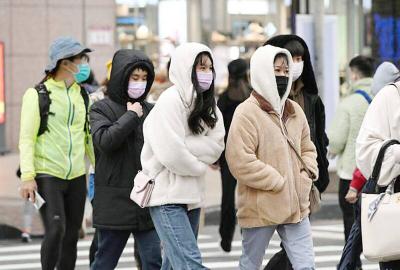Showing video clips of rabbits in tiny boxes and rows of horseshoe crabs having their blood drawn, representatives from an animal welfare group and legislators yesterday urged the government to amend regulations to reduce unnecessary animal testing for drug production.
After conducting an investigation of 25 local pharmaceutical companies between 2006 and this year, the Environment and Animal Society of Taiwan (EAST) said it found that all 25 firms did animal testing — 18 companies used rabbits for pyrogen testing, while seven companies used horseshoe crabs for Limulus amebocyte lysate (LAL) testing.
An EAST research member said that while animal testing is usually not required in the production of generic drugs — drugs for which the patent has expired and that can therefore be made by other pharmaceutical companies — pyrogen testing still uses animal subjects. Pyrogen testing is undertaken to detect if bacterial toxins are present in vaccines and medications that could cause fever in humans.

Photo: AFP / Mandy Cheng
Rabbits used for pyrogen testing are often locked in tiny boxes for more than three hours during the experiments, and liquids are intravenously injected into their ears to observe changes in their body temperature, she said.
Because rabbits are easily frightened, some die during the tests, while others are repeatedly subjected to abuse, she added.
EAST director Chen Yu-min (陳玉敏) said anxiety may cause the rabbits’ temperature to rise during the tests, and forcing them into a fixed position for hours may also cause their blood circulation to slow — both of which affect the accuracy of the tests.
The LAL testing method uses blood drawn from live horseshoe crabs, but the crabs grow very slowly, usually taking from 13 to 14 years to grow into full adulthood. Some researchers have suggested designating the crabs as a protected species, the EAST member said.
Because the crabs’ maximum tolerance to blood withdrawal is not known, many horseshoe crabs die when drained of too much blood during tests, she said, adding that death rates from these tests are between 10 percent and 20 percent.
Quoting Council of Agriculture statistics, the group said an estimated 19,500 rabbits have been used for pyrogen testing alone in the past 30 years, and that while rabbits have a life expectancy of about five to 10 years, many of the those in tests die in three to four years.
The group said the European Centre for the Validation of Alternative Methods has developed an alternative methods that are more effective for detecting pyrogen, such as the Monocyte Activation Test (MAT), which uses human blood.
Food and Drug Administration senior technical specialist Wang Der-yuan (王德原) said the agency is uncertain whether pyrogen testing can be fully replaced with MAT, but that it would add the method to the Chinese Pharmacopoeia.

ALIGNED THINKING: Taiwan and Japan have a mutual interest in trade, culture and engineering, and can work together for stability, Cho Jung-tai said Taiwan and Japan are two like-minded countries willing to work together to form a “safety barrier” in the Indo-Pacific region, Premier Cho Jung-tai (卓榮泰) yesterday said at the opening ceremony of the 35th Taiwan-Japan Modern Engineering and Technology Symposium in Taipei. Taiwan and Japan are close geographically and closer emotionally, he added. Citing the overflowing of a barrier lake in the Mataian River (馬太鞍溪) in September, Cho said the submersible water level sensors given by Japan during the disaster helped Taiwan monitor the lake’s water levels more accurately. Japan also provided a lot of vaccines early in the outbreak of the COVID-19 pandemic,

Kaohsiung Mayor Chen Chi-mai (陳其邁) on Monday announced light shows and themed traffic lights to welcome fans of South Korean pop group Twice to the port city. The group is to play Kaohsiung on Saturday as part of its “This Is For” world tour. It would be the group’s first performance in Taiwan since its debut 10 years ago. The all-female group consists of five South Koreans, three Japanese and Tainan’s Chou Tzu-yu (周子瑜), the first Taiwan-born and raised member of a South Korean girl group. To promote the group’s arrival, the city has been holding a series of events, including a pop-up

TEMPORAL/SPIRITUAL: Beijing’s claim that the next Buddhist leader must come from China is a heavy-handed political maneuver that will fall flat-faced, experts said China’s requirement that the Dalai Lama’s reincarnation to be born in China and approved by Beijing has drawn criticism, with experts at a forum in Taipei yesterday saying that if Beijing were to put forth its own Dalai Lama, the person would not be recognized by the Tibetan Buddhist community. The experts made a remarks at the two-day forum hosted by the Tibet Religious Foundation of His Holiness the Dalai Lama titled: “The Snow Land Forum: Finding Common Ground on Tibet.” China says it has the right to determine the Dalai Lama’s reincarnation, as it claims sovereignty over Tibet since ancient times,

Temperatures in some parts of Taiwan are expected to fall sharply to lows of 15°C later this week as seasonal northeasterly winds strengthen, the Central Weather Administration (CWA) said today. It is to be the strongest cold wave to affect northern Taiwan this autumn, while Chiayi County in the southwest and some parts of central Taiwan are likely to also see lower temperatures due to radiational cooling, which occurs under conditions of clear skies, light winds and dry weather, the CWA said. Across Taiwan, temperatures are to fall gradually this week, dropping to 15°C to 16°C in the early hours of Wednesday